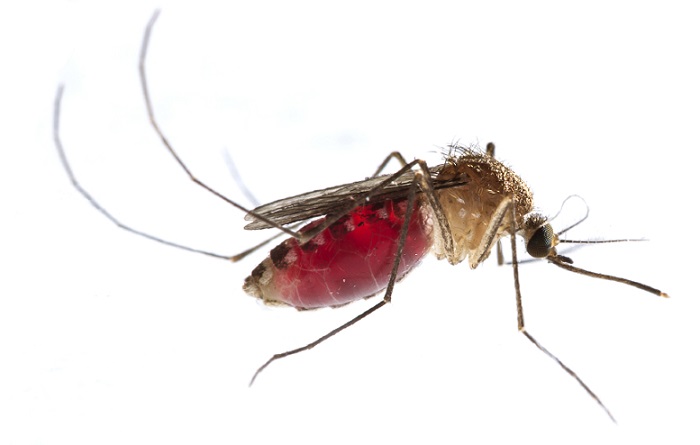
Mosquito and Biting Fly Extermination
Ontario has 64 mosquito species and 5 of these species: Coquillettidia perturbans, Ochlerotatus stimulans, Aedes vexans, Culex pipiens/restuans and Anopheles punctipennis are considered nuisance mosquitoes in Ontario because of their large numbers and their preference for humans or livestock as a blood meal source.
Mosquitoes are prolific breeders and depending on environmental factors are capable of significant population growth. Mosquito development begins in water either for egg oviposition or the development of immature stages; therefore water levels, rainfall, and temperature all impact Ontario’s mosquito population.
The female mosquito requires a blood meal to complete the development of her eggs and during her lifetime she will typically blood feed two or three times on birds, animals or humans and will then lay several hundred eggs after each blood meal in or near stagnant water. Development from egg to adult in ideal environmental conditions usually takes 7 days for the fully developed adult to emerge.
Depending on the mosquito species eggs can be laid on water or in moist soil either alone or as part of an egg raft near ponds, ditches or anywhere water pools and accumulates. Some eggs are drought resistant and can endure for several years in dry conditions and still remain viable, other eggs are attached to vegetation above the water line.
Female mosquitoes only mate once during their lifetime and after mating require blood meals as well as carbohydrate meals whereas male mosquitoes feed exclusively on floral nectar or aphid secretions.
Mosquitoes are considered important vectors as they transmit a variety of pathogens such as: West Nile Virus (WNV), St. Louis Encephalitis (SLE), Western Equine Encephalitis (WEE), Eastern Equine Encephalitis (EEE), Dengue (DEN) and Malaria.
As mosquitoes are both diurnal and nocturnal biters controlling mosquitoes and minimizing their ability to impact humans and livestock requires a thorough understanding of their bionomics combined with careful inspection for environmental viability support.
Best Management Practices including surveillance, mapping, establishment of action thresholds, source reduction, physical controls, biological controls, efficacy monitoring, resistance monitoring, community education/communication and comprehensive record keeping are the basis for our Integrated Mosquito Management programs for our Residential, Commercial, Governmental and Agricultural clients throughout Ontario.
Mosquito IMM Control Programs
Warrantied Extermination's Integrated Mosquito Management is a comprehensive mosquito prevention and control strategy that utilizes all available mosquito control methods to exploit the known vulnerabilities of mosquitoes to reduce their potential impact on Ontario residents and livestock.
All of our programs, whether residential, commercial, governmental or agricultural are fully compliant with all governing legislation including Ontario Regulation 63/09 under the Pesticides Act as well as the Ontario Health Protection and Promotion Act (HPPA) Regulation 199/03.
Residential Services – Private Homes and Event Properties, Condominium/Apartment Complexes Recreational lands
Adulticide Treatments during Peak Nuisance Mosquito Periods
We provide adult mosquito extermination through adulticiding treatments for private homes, private event facilities, condominium complexes, apartment complexes and recreational lands such as amusement parks as a land based extermination with ULV fogging and residual chemical applications or with non-chemical carbon dioxide mosquito trapping devices.
Both methods are used to quickly but temporarily control adult mosquitoes. These treatments are provided in conjunction with breeding source reduction activities to support long term mosquito activity reduction on your property. We ensure that all adulticiding exterminations completed are fully compliant with all regulatory conditions including community notification requirements.
All chemical treatments respect Ministry of Environment (MOE) Ontario guidelines requiring 75 metre neighbour buffers as well as 100 metre environmentally sensitive area buffers. Our services for these types of properties also can include surveillance and threshold monitoring with landing counts or light trap monitoring to provide treatments at pre-established intervals.
Private Land Prevention and Control Programs:
• commercial and industrial properties
• railways
• shopping centres
• farms
• condominium/apartment complexes
• zoos and conservation authorities
• municipalities
• utility companies and federal agencies
Comprehensive mosquito control programs including water based larviciding and ground and/or aerial adulticiding programs are available for complex private landholders by our Ontario licensed Mosquito & Biting Fly, Aerial, and IPM Industrial Vegetation exterminators. We provide program development support from start to finish to ensure compliance with MOH health hazard directives under Section 13 of the Ontario Health Promotion and Protection Act (HPPA) 199/03 for the control of West Nile Virus which will complement your existing municipal or health unit mosquito abatement programs and ensure seamless integration for your properties is in place prior to MOH mandates.
Warrantied Extermination's private lands control programs include full support and assistance in the development and maintenance of a fully compliant mosquito abatement program including:
Mosquito species identification, species specific activity level determination and treatment threshold establishment to determine the location and timing of larvicide and adulticide applications in order to support community wide efforts to disrupt the transmission cycle of WNV We provide structured collection of mosquito immature stages using larval dips and mosquito adults using light traps with capture locations identified, logged and sent for laboratory species identification consistent with best practices. Habitat Modication techniques such as water depth management, water flow and surface agitation, water quality management.
We also provide complete MOE permit submissions for both previous and new applicants including provision to MOE of hard copy maps/electronic maps to scale (1:25,000), digital mapping coordinates, completed permit application forms, enabling HPPA order, authorization letters, sensitive area identifications, catch basin locations, proof of water extermination insurance, treatment area boundaries, compliance with MOE Monitoring Requirements both pre/post chemical application, and annual summary report submissions.